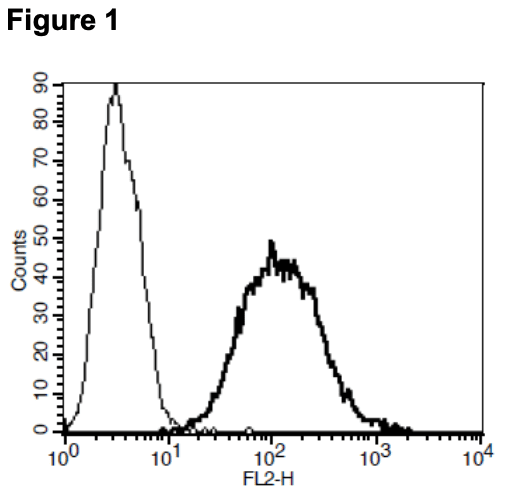Product Information
Catalog Number:
MC1076-3a
Lot Number:
MC1076-3a-091115
Quantity:
19.2 mg/ml, 5 mg
Packaging Buffer:
20 mM Gly-Gly, 1 mM MgCl2, 25 mM Sucrose (pH 7.2)
Host cell:
1321N1
Transfection:
Expression vector containing full-length human GPR17cDNA (GenBank Accession Number NM_005291) with FLAG tag sequence at N-terminus
Recommended Storage:
Liquid nitrogen upon receiving
Data Sheet
Background: G-protein coupled receptor 17 (GPR17) is closely related to the purinergic and cysteinyl-leukotriene receptor families. It is present on both neurons and a subset of oligiodendrocyte precursor cells. Recent studies have shown that GPR17 plays an important role in both sensing and repairing brain damage. Thus, GPR17 represents a potential new target for the treatment of traumatic brain injuries as well as neurodegenerative diseases like Alzheimer’s and multiple sclerosis.
Application: Functional assays

Figure 1. Receptor expression on cell surface measured by flow cytometry (FACS) using an anti-FLAG antibody. Thin line: parental cells; thick line: receptor-expressing cells.
References:
Franke, Heike et al. “Changes of the GPR17 Receptor, a New Target for Neurorepair, in Neurons and Glial Cells in Patients with Traumatic Brain Injury.”Purinergic Signalling 9.3 (2013): 451–462. PMC. Web. 18 Feb. 2015.
Hennen, S et al. “Decoding Signaling and Function of the Orphan G Protein-Coupled Receptor GPR17 with a Small-Molecule Agonist.”Sci Signal 2013 Oct 22;6(298)
Lecca, Davide et al. “The Recently Identified P2Y-Like Receptor GPR17 Is a Sensor of Brain Damage and a New Target for Brain Repair.” Ed. Kenji Hashimoto. PLoS ONE 3.10 (2008): e3579 PMC. Web. 18 Feb. 2015.
